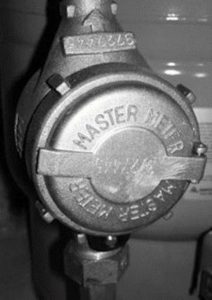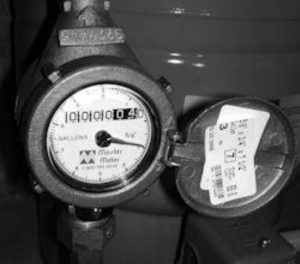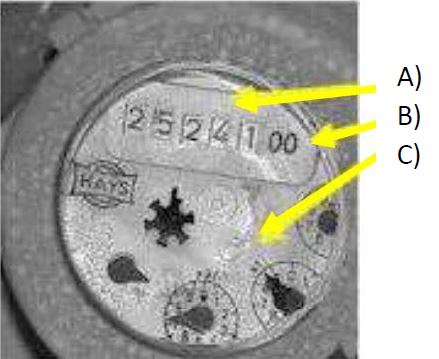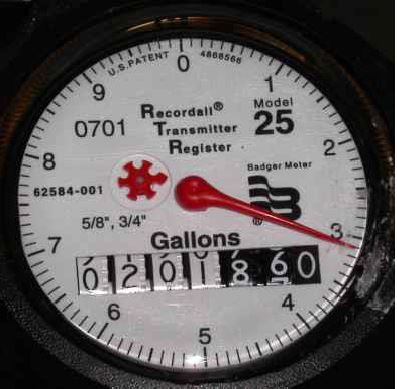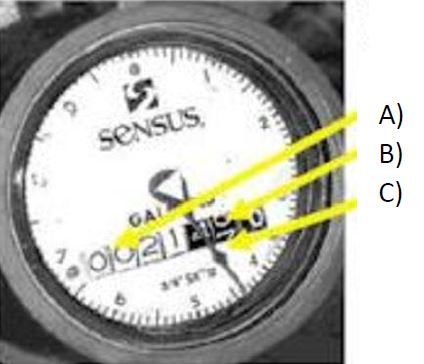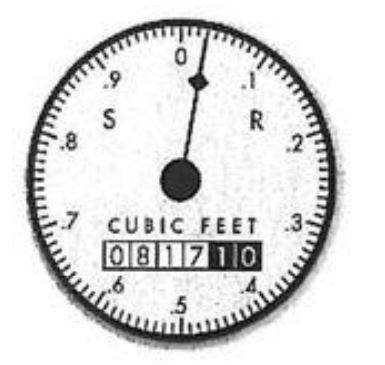How To Read Your Water Meter
Your water allotment contract allows for a certain amount of usage each month from a single or multiple sources of supply. Sources of supply are typically a well, spring, or surface diversion. Your contact requires that you monitor diversions from each source of supply on a monthly basis and report the total monthly diversions to the Basalt Water Conservancy District (District) by November 15th of each year. 1) Totalizing flow meters are typically used to monitor flows from wells and flows from springs and surface diversions if the water is pressurized in a pipe. 2) The memorandum covers diversions from totalizing flow meters only. If you need additional information with regards to monitoring your spring or surface diversion, please contact the District’s Engineer at 970-945-6777.
Once you obtain your water allotment contract is associated with well diversions, you will need to repermit your well(s) with the Colorado Division of Water Resources. Once the new well permit is issued, it will confirm the amount water that can be diverted under your District contract. This usage is limited by your type of use and the amount of contact water you obtained from the District. Most uses include normal in-house use and a limited amount of outside irrigation. You may check with the District to determine or confirm irrigation limitations. Your water allotment contract is based upon a depletion amount or the amount consumed; that is the amount not returned to the system via your sewer system or not returned through the ground from irrigated landscape. This amount consumed is less than the total amount diverted or pumped. Meter readings measure the total amount diverted or pumped since the meter was installed. This is called a totalizing flow meter.
Totaling flow meters come in a variety of makes and models. Likewise, your meter may measure water in gallons, acre feet (AF) or in cubic feet (CF). Water meters may be located in a meter pit outside or in the mechanical room of your residence. For residences served by wells, this will typically be an unfinished room in the basement probably where the furnace is located. However, the pressure tank and water meter may also be found in the crawl space of the home when there is no basement. Check around the bottom floor of your house and look for a cylindrical tank connected to copper pipe. This tank keeps your water system pressurized when the well pump isn’t running. The water meter may be located on the copper pipe very close to the pressure tank. It might have a protective plastic or bronze cover over the dial that you will have to lift to see the meter face. The cover can be easily opened to expose the meter dial.
Most meters utilize gallons as the unit of measure; however, however your meter could be in Acre-feet (AF) or Cubic-feet (CF). For your information, below are conversions for AF and CF to gallons:
1 AF = 325,851 gallons 1 CF = 7.48 gallons
- Beneficial uses associated with evaporation from surface diversions or springs do not need to be measured under your District contract. Diversions associated with evaporation from surface diversions or springs are calculated by approved methodology from the State. Please note on your meter reading form if your contract includes evaporation under the comments section.
Please note that if your contract is associated with a subdivision, the Colorado Division of Water Resources may require that you also submit monthly readings. - For springs and surface diversions that are by gravity (i.e. not pressurized), a Parshall flume or weir typically measures the flow.
Below are listed several figures picturing different styles of meters:
Typical pressure tank with a water meter location depicted.
Water meter with the cover in place.
Water meter with the cover in the open position.
Hays meter with multiple dials. The correct reading is 2524100.
A) Only submit the digits on the face of the meter.
B) Include painted zero(s) to the right of the changing digits.
C) Do not read and report from the rotating pointers.
Typical meter with a sweep dial. The correct reading is 201860.
Submit only digits on the face of the meter. If there is a sweep dial (red pointer), just ignore it. Include any tailing zero(s) including any painted on the face of the dial. Ignore any leading zeros.
A Sensus meter with digits that are ready to change. The correct reading is 21470.
A) Do not report any leading zero(s), but DO include zeros(s) at the end.
B) If a number is changing, report the higher number (7 in this example).
C) Do not report the number indicated by the sweep dial.
Depicts a meter in cubic feet
The correct reading is 81710. The reading is taken from the numbers shown under the words “CUBIC FEET”. The meter reads 81710, which is the total number of cubic feet of water diverted through the meter since it was installed. Report all numbers in the digital register. Do not report the number indicated on the sweep dial.
Do You Have A Leak?
Excess diversions under your contract may be due to leaks and it is your responsibility to fix them. Most leaks are from running toilets or broken irrigation lines. Toilet leaks can be as small as 30 gallons per day (typically silent) and to as much as 5 gallons per minute. A broken irrigation main or lateral line 1-inch in diameter or smaller can waste between 1,200 to over 3,000 gallons per hour.
How to check for leaks:
- Turn off all water inside and outside of your home. This includes ice makers, dishwashers, sprinkler system, and all faucets.
- Locate your water meter. This is usually in the basement or crawl space of your home.
- Locate the leak indicator (if you meter has one). Leak indicators may be star shaped or triangles. They are typically red, blue, or silver.
- If you have a leak indicator, check to see if it is moving. If it is moving, this tells you that water is moving through your system and indicates a leak.
- If the leak indicator is not moving or you do not have a leak indicator, move to Step 6). Step 6) will check for subtle leaks and leaks that stop and start (such as toilet leaks).
- Locate the rotating hand and record its position and the digits on the face of the meter.
- Wait at least 20 minutes (wait an hour or two if possible) then check the water meter again.
- If the rotating hand has moved or the digits have changed, this indicates a leak.
If your meter indicates a leak:
- First double check that all water sources have been turned off.
- Check under sinks for any moisture around pipes.
- Check to see if you have a running toilet (a running toilet can double your water usage).
- Check your sprinkler system and outside hoses.
- Most leaks can easily be fixed by yourself; however, for large or unidentified leaks, you may need to call your local plumber.


